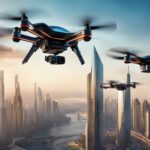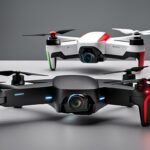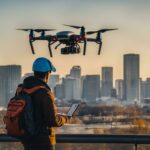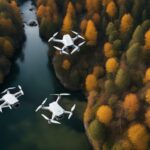Interested in knowing whether your drone can endure rain?
Typically, operating drones in conditions of rainfall, foggy ambiance, or extreme humidity and also above water surfaces experiencing robust winds is not endorsed. There are several drone models with ventilation gaps that could leave the internal electronics vulnerable to dampness. If any moisture infiltrates these openings there’s a considerable risk of triggering short circuits which may subsequently wreak havoc on your device’s functionality.
Put that question aside! We’re about to embark on a journey into the realm of navigating drones during inclement weather. We’ll examine IP ratings and their significance, which contribute to assessing a drone’s water resistance.
Come learn about the restrictions DJI Mini Drones have concerning wet conditions and how one could determine its ability to withstand rainfall.
Let’s delve deeper into discussing potential risks along with associated preventive measures while soaring under rainy skies.
Keep going through this write-up so as not only to preserve but also to ensure the safety of your beloved flying gadget.
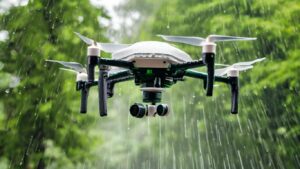
Key Takeaways: Can Drones Fly in Rain
- IP ratings for drones indicate their resistance to solid particles and liquids.
- An IP rating of at least IP43 is recommended for flying a drone in the rain.
- DJI Mini drones and similar models are not designed for flying in the rain and do not have an IP rating.
- Flying a drone in the rain can damage electronic components and compromise stability and control.
The Importance of IP Ratings for Rain Flying
Comprehending the significance of IP ratings is key for maintaining your drone’s function and safety in rainy conditions. The term ‘IP’ symbolizes Ingress Protection, a measure of a gadget’s resilience to solids and liquids.
In relation to drones, we use IP ratings as an index indicating their capacity to withstand wet circumstances under various scenarios. These assorted IP ratings form a protective scale against water exposure that spans from devoiding any safeguard up to standing firm against heavy-water jets.
Assessing how rain affects the function of drones, a minimal IP rating of IP43 is suggested for flights in mild rainfall. But bear in mind that such ratings do not necessarily promise optimal operation or flight capability under these conditions.
It’s crucial to delve into waterproofing strategies; nevertheless, always refer back to your drone’s instruction guide or reach out directly to its maker for a precise understanding of exposure limitations during rain.
Understanding the Limitations of DJI Mini Drones in Rainy Conditions
For those who possess a DJI Mini drone, it’s important to understand the device’s constraints in dealing with wet weather. Models such as DJI Mini 2 and DJI Mini 3 are not made for flight during rainfall. These drones cater to everyday consumers and enthusiasts prioritizing cost-effectiveness, lightness, and ease of operation over other features.
Introducing an IP rating would only make these devices pricier and more complex than needed. The manufacturers ensure that they keep them reasonably priced yet lightweight; hence no provisions enable their use under adverse circumstances like heavy showers or rainstorms intrinsic from their build structure onward – They simply lack an IP rating required for safe flights amidst downpours.
| Waterproofing Techniques for DJI Mini Drones | Exploring Alternative Drones for Flying in Rainy Conditions |
|---|---|
| – DJI Mini drones do not have built-in waterproofing techniques. | – If you need a drone that can fly in rainy conditions, consider exploring alternative options. |
| – Adding IP-rated waterproofing to DJI Mini drones would increase their cost and complexity. | – Look for drones specifically designed for flying in the rain, such as the DJI Mavic 2 Enterprise Dual or Autel Evo II Dual. |
| – Aftermarket waterproofing solutions are available, but they may void the warranty and require careful installation. | – These drones often come with higher IP ratings, providing better protection against water. |
| – It is essential to follow proper waterproofing instructions and guidelines to protect the drone from water damage. | – Before purchasing a drone, check its IP rating and ensure it is suitable for flying in rainy conditions. |
DJI Mini drones might fall short in terms of functionality during wet weather, however, other substitute choices exist for individuals who need a drone that can withstand these conditions.
Choosing a drone with an elevated IP rating and inherent water-resistant attributes after thorough research is key. Opting for specific alternative drones crafted to fly under rainy circumstances guarantees not only safety but also dependability even amidst unfavorable meteorological situations.
How to Find Your Drone’s Rain Rating
Refer to your UAV’s user handbook, the maker’s webpage, or e-commerce platforms for its IP rating. This value–the Ingress Protection indicator –suggests how resilient it is towards solids and fluids. Look out for labels such as IP43, IPX6, IPX7, or even an elevated level of protection offered by something like the robustness of an IPX8 specification status. The ratings you find here give a clear indication of the different degrees to which your drone could shrug off water under various circumstances.
It’s advisable to use a drone with at least an IP43 certification for uninterrupted flight in light rainfall. This signifies that the drone can withstand water sprayed up to 60 degrees from vertical, making it ideal for drizzling conditions. If this specification isn’t immediately apparent, guidance could be sought via online user reviews or by browsing discussions on related forums.
Furthermore, ponder over water-resistant methods for drones and delve into waterproof improvements to boost your drone’s capacity against moisture.
Risks and Considerations for Flying a Drone in the Rain
Steer clear of piloting a drone under rainy conditions unless you fully comprehend the implications and have taken the required safety measures. Evaluating how rain can affect your drone’s battery longevity is key to providing secure and flawless flights.
Rain has pronounced effects on reducing a drone’s battery power due to heightened drag as well as greater energy demands for stable functioning in damp atmospheres. Looking into various safeguarding strategies while navigating drones in moist scenarios plays an imperative part in lessening possible harm.
Consider various ways to safeguard your drone against water damage, such as choosing waterproof covers or cases specially made for drones. You could also apply protective coatings that resist water on the electronics of the drone, or use sprays designed for waterproofing.
Do remember though; that no prevention method can offer an absolute assurance of protection in intense rainfall. The safety and upkeep of both you and your drone should be paramount—try avoiding exposure to hostile weather conditions whenever feasible.
Precautions and Recommendations for Rainy Weather Drone Flights
Is it recommended to take specific steps when piloting your drone in inclement weather conditions like rain? Certainly! Taking special care ensures a protected and successful airborne journey amidst the showers. Here are some safety measures and suggestions you should think about:
| Precautions | Recommendations |
|---|---|
| Check your drone’s IP rating for water protection | Avoid flying a drone in the rain unless it is designed for such conditions |
| Take appropriate precautions to prevent water damage, such as waterproofing the drone | Check the weather forecast before flying in rainy conditions |
| Consider getting drone insurance that covers water damage | Properly care for the drone after flying in the rain, including shaking off excess water, drying, inspecting for damage, and storing in a dry place |
Frequently Asked Questions
Can I Fly Any Drone in the Rain if I Waterproof It Myself?
Indeed, it’s possible to try and make a drone rainproof in order to operate it during wet weather. But remember that this carries associated hazards and boundaries. The techniques for waterproofing differ based on the model of the drone as well as its features/components. Conducting an exhaustive study prior to putting such attempts into action is vital.
Waterproofed or not, there are underlying threats like weakened electronics systems and lessened clarity/visibility still present. It would be prudent if you could review your drone manual thoroughly, start from advice provided by manufacturers, and weigh out advantages over drawbacks preceding any efforts in trying flight under rainy conditions.
Are There Any Drones Specifically Designed for Flying in Heavy Rain?
There are indeed waterproof drone models crafted precisely for handling severe rainfall. They boast of high IP ratings which provide them with the utmost shield against water.
It’s crucial to highlight that notwithstanding an appropriate IP rating, launching drones in the rain is not without risks. Optimal protocols when operating drones amid the shower encompass verifying the drone’s IP grade, adhering to maker instructions, fortifying your device against seepage if needed, and implementing preventive measures thwarting moisture infliction.
For specialized advice consult either the manual assigned to your drone or get in touch directly with its producer.
Will Flying a Drone in the Rain Void Its Warranty?
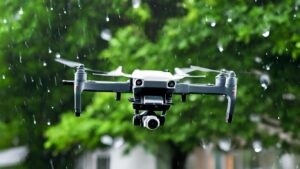
Piloting a drone amidst rainfall could potentially invalidate the warranty. The performance of drones can be adversely affected by rain, resulting in harm to electronic parts and jeopardizing their stability and control.
Be sure to review your user manual for the drone or conduct extensive online research about IP rating along with the manufacturer’s advice on operating under moisture-filled conditions. A few preventative steps like enforcing waterproof measures onto your device coupled with monitoring local meteorological predictions might just safeguard it against potential breakdowns while also evading any complications regarding warranties.
How Long Can a Drone Fly in the Rain Before It Becomes Damaged?
Piloting a drone in rainy weather could potentially result in degraded performance and longevity. If not effectively waterproofed, rain can harm the electronic parts of the device thereby threatening its steadiness and command.
Considering the drone’s IP assessment for water resistance is crucial as well as following instructions imparted by its maker. Avoid using drones amidst precipitation unless they are specially engineered for that setting.
Conducting preventive measures like efficacious waterproofing, scanning local meteorological updates, along appropriate post-flight care might aid in abating possible damages.
Can I Fly a Drone in Light Rain if It Doesn’t Have an IP Rating?

Should your unmanned aerial vehicle lack an IP rating, it’s not suggested you operate it under even slight rainfall. The rain may negatively affect the drone’s efficiency and balance, potentially causing harm to electronic parts and interfering with sensor operation.
For protecting your drone against adverse effects of moisture or wet conditions such as rain, contemplate methods like waterproofing plus safety measures that include regular weather monitoring pre-flight, drying off post-usage, and storing in a dry environment for a prolonged period.
Priority should always be given to security practices alongside adhering strictly to provided manufacturer directions when dealing with unfavorable climatic circumstances.
Conclusion
Wrapping things up, before you venture out with your drone in wet weather, the IP rating is fundamental to take into account. You must have a clear understanding of how much rainwater resistance your drone can handle for its longevity and protection.
Although certain drones sport higher IP ratings making them more suitable for light showers, usually flying under rainy conditions isn’t advised so as not to harm important components in your drone.
Following precautionary steps properly paired with compliance towards manufacturer guidelines will give an assurance on prolonging the life span and safety features embedded within one’s own drone.



